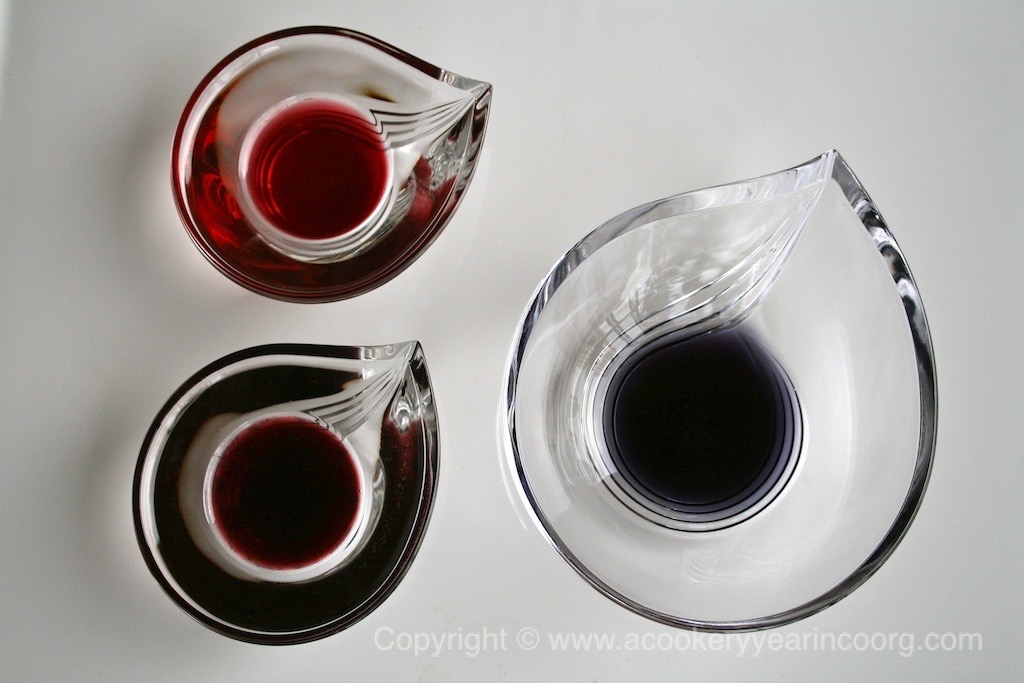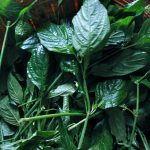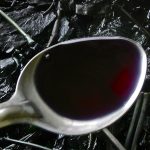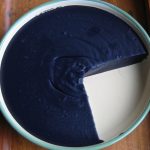While I’m eating blueberries by the handful, back in Coorg, people are getting their own colourful food fix. The wet, dark months of the monsoon bring about a mysterious transformation in an otherwise quite unremarkable plant known locally as “maddu thoppu”, lit. medicine leaf (Justicia wynaadensis).
This plant grows wild around Coorg, favouring moist, shady areas. During the month of the most intense monsoon rain*, mid-July to mid-August, a period known as “kakkada”, an extract is made from boiling the stems and leaves in plenty of fresh water. The extract has a peculiarly medicinal fragrance and the colour can range from shades of magenta, through to deep purple and, when at its strongest, indigo.There is a countdown to the day when it is believed the potency of the plant is at its peak.
Making Maddu Thoppu extract
Pack a large, deep saucepan 3/4 full with maddu thoppu stems and and leaves. Cover with cold water and cook on a very gentle simmer for about 1 1/2 to 2 hours. Make sure the leaves are immersed at all times. Strain and reserve the deeply coloured liquid and discard the stems and leaves.
The extract is used to prepare various dishes like maddu kuul, which is simply rice cooked in the extract, maddu payasa, a sweet rice pudding, or maddu puttu, an unsweetened rice cake that can be eaten with ghee and honey, or a jaggery syrup. It may be an acquired taste, but maddu thoppu certainly has a loyal fan following!
My favourite version is definitely maddu puttu.
Maddu puttu
An unsweetened rice cake with the texture of blancmange.
- 1 cup raw rice, soaked for 12 hours
- 3/4 tsp salt
- 5 cups of maddu thoppu extract
Drain the soaked rice and grind it to a very smooth paste with 1/2 cup of the maddu thoppu extract. Add the remaining liquid and salt and cook the mixture on gentle heat, as you would a custard.It should begin to thicken in 10-12 minutes (sooner if the extract is freshly made and still hot).
Stir constantly and do not allow lumps to form. When the mixture is very thick and no longer of pourable consistency, (another 5 minutes or so), spoon it very quickly into ungreased thalis or dhokla plates. Thump the plates on the countertop to level the mixture but do not smooth the surface as it disturbs the beautiful sheen.
Cool and cut into slices. Eat with a drizzle of honey and ghee. Feel the medicine working.
No access to maddu thoppu?
Try the same recipe with beetroot juice! This is a Kuih-inspired something I came up with in a fit of monsoon nostalgia, with maddu thoppu a very long way away. It’s pretty tasty and, besides, beets are good for you!
Grind 2/3 cup peeled, chopped beets per cup of juice you plan to use and top up the measure with water. Strain and reserve the pulp for beetroot halva or a thoran.
Proceed as for the maddu puttu recipe. I like to add a little sugar and ground cardamom to taste. Sugar present in the beets and any added sugar will affect the way it holds together, so it has a softer set.
Serve the “beetroot puttu” in scoops with thick coconut milk!
*Many years ago I tried growing some maddu thoppu in Bangalore, watching closely for signs of purpleness during the rather tamer monsoon there. No luck!





During several of the dark rainy days in August here in British Columbia, I have thought about the Madd Puttu, it’s distinct aroma and taste, reminiscing about the 18th day in Kakkada where my mother would make Madd Puttu, Madd Payasa or Madd Halbai(kind of a Halwa) made out of this Madd Thoppu extract.
Your above write up on Madd Thoppu brought back all those lovely memories of growing up in Coorg, waiting for the 18th day in Kakkada to eat Madd Putt for Breakfast, lunch and dinner:)
My mother’s description of how this special extract contained every medicinal value and how this would make us all super healty, still rings in my ear.
Awesome job Shalini, it is a great read and brought back beautiful memories. Love the way you write.
Thank you, Vindhya! Btw, did you ever learn what exactly those mysterious medicinal properties are? I needed no persuasion to eat it in any form, but there are those who flee at the mention of the stuff!
I’ve never had the halbai version, now I have one more on my list of “must tries”.
Wouldn’t it be great it if UBC could be persuaded to grow this Justicia in their plant collection? I am sure they have a facility that mimics the highland tropical climate of Coorg. Various other species of Justicia growing worldwide could be brought together for comparative metabolic & genetic studies, if warranted. We have the concept of primary, secondary and tertiary gene pools: through genomic & genetic studies, discover the group that is most closely related, & which will crossbreed with relative ease. The secondary pool crosses with greater difficulty & requires special technique. The third pool is yet more distant & a reservoir of genes of interest.
The importance of this effort lies in investigating the chemistry of the compounds and their activities against various pathological conditions: the pharmacognosy aspect.
Beyond pharmacognosy lies investigating the metabolic pathways that produce these chemicals. Some claim that approximately 25% of the modern pharmacopeia has roots in chemicals originating in plants and fungi [I don’t know whether they include microorganisms of various classes].
In any case, this could be a useful science project in India too, where there are many very competent natural products chemists who need a little urging from the right quarters.
Researching a bit more, went to the USDA database :
http://www.ars-grin.gov/cgi-bin/npgs/html/genus.pl?6233
“Possible synonyms for the genus” turned up a taxonomic minefield!!!!!!!!!!
1. The taxonomy of this large genus is unsettled & needs modern genomics!!
Even crops as intensively studied as breadwheat, durum & barley are barely giving up the details of their complex relationships, and evolution [that once was thought to have been settled!!]. So how much MORE is left to be studied for these medicinals!!
2. One classification includes it in the genus ADHATODA, the same one that contains the famous Ayurvedic VASAKA, Adhatoda vasica.
We MIGHT [or NOT!!] get a clue to the medicinal properties of this Justicia by aligning our thoughts along VASAKA lines: a cough & catarrh medicine. So is the Purple Rain arriving just in time to ward off chills, colds, fevers, and ills of this type associated with heavy rain?
Pure speculation.
I know from experience, that rice planting in flooded fields exhausts the typically thin Indian body and that water with specific heat of 1 is the greatest vampire of body heat.
Q, number of Joules from one system = mass x sp.heat of water x delta Temperature in Kelvins
Compare the mass of an individual with the immense mass of water in a paddy or exposed to rain, and the significant difference in temperature, at least 20-30C, and the duration of exposure for field hands, and you will see how critical the heat loss is. People get ill, have pneumonia, even in the torrid plains!
Shalini wrote & inquired about the seasonal production of Madu Thoppu, during the time of most intense rain. A botanist suggested “lack of sunlight”. My comment here will tend to get awfully long-winded & pedantic.
Even without knowing what the compound is, we can make some generalizations about the common metabolic pathways which most plants use to synthesize the precursors for all complex compounds such as dyes/colors, drugs, some fragrances/essential oils (terpenes), toxins, etc.
All new building blocks are made in the leaves and the plant essentially has glucose molecules [ring shaped structures] and a few amino acids to juggle around, add, subtract, turn somersaults & do more clever tricks than all Indian politicians combined, to make up everything else.
What we are interested in, color, medicinal aroma, maybe a slight bitterness & astringency, derives from the shikimic acid pathway which creates a ring molecule, cinnamic acid, that itself becomes the precursor of the PHENYLPROPANOID PATHWAY, that synthesizes the multi-ringed molecules that make up the color,medicinal taste etc. Some of the bitterness may come from this or from another pathway.
What happens just before the cinnamic acid is produced is very germane here: this is a very important control point, regulated by an enzyme named PAL [just for now]. PAL responds to external stimuli, especially “stress” or njury. This can include drought, high levels of ultra-violet radiation (as in too much sun), mechanical injury, herbivory by bugs & animals and pathogen attack. There are even more stimuli, but…..
The response is to gear up & manufacture MORE of the downstream product, cinnamic acid, which presumably would lead to a rise in the purple cocktail of compounds. That would be the logic, but it fails that test in Bengaluru.
“Lack of sunlight” usually is not a direct trigger for metabolic pathways of this nature. High levels of challenge by fungal & bacterial pathogens may be a factor, when rainfall is increasing/peaking. All the flavor & color compounds we treasure in wine grape skin are primarily plant defense agents. So too, the purple medicinal juices.
“Lack of sunlight” is an indirect way of expressing “High levels of pathogen challenge.”
In Bengaluru” drier climate, there was only a low level of pathogen challenge, or the pathovars [distinct localized races of the naughties] were different.
BTW, high levels of sunlight often is the trigger that allows certain fungal spores to germinate on leaves. Therefore, it is not true that all disease organisms prefer wet & low light.
However, very low light levels can also affect the Nitrogen –>Nitrate/Ammonium–> Protein metabolism within leaves, but one would suppose this plant to be evolved for whatever niche it occupy. So that trigger & low light levels can be eliminated for the reason why Maddu Thoppu is produced when it is.
It would have been easier to just state an opinion, and FAR less annoying to the reader. However, by trying to offer the reasoning behind the answer, one avoids the danger of being arbitrary. The reader may take this logic chain to a more learned person, and receive a more cogent critique. Cronquist is a name I recognize at UBC.
Wow! Purple rain gives way to purple haze.. 🙂
Thank you so much for taking the time to write that, Gautam.
( In all fairness, the person who mentioned a lack of sunlight as a possible factor is someone whom I asked quite casually and in passing, so quite likely the effort involved in a lengthy reply like yours wasn’t an option!) Have you seen today’s google doodle?
Maddu thoppu does indeed arrive at a time when the land is absolutely under siege by merciless rain- the month between mid- July and mid- August is quite formidable, even with all of today’s mod cons. While the local population was relatively robust and well fed, there was plenty of danger lurking in the form of fevers, infected sores and leech bites (!), malaria and the like. There seems to be at least one pharmaceutical patent applied for. Very interesting reading about Adhatoda vasica. I looked at some images and fwiw, the flowers look like larger versions of the ones I remember on the maddu thoppu plant grown in Bangalore.
It’s hard to describe the fragrance of the extract, and while it does have “medicinal” undertones, I find it quite mellow and soothing, rather like vanilla. Maybe it;s just me.:-)
Thanks Shalini for this wonderful post . This time I am going to skip the bit about your wonderful writing and the pictures and cut to the chase . I dremember having a payasam of Madhe Thopu at my father in law’s brothers place , Gappu uncle in the year 1992. We had come to Bangalore form Delhi for holidays in the second half of August. The payasm was distinctly purple and I really loved it . So glad about that, as not being from Coorg I would have felt miserable if I did not take to this like duck to water . This morning I had a long chat with my Mil , wanted to know if Rani aunty had got the leaves form Coorg that day or was it growing in the kitchen garden . Mother in law has conformed that it was growing in their kitchen garden and that she had in fact given her cuttings as well which she had cultivated to great success in her own garden , the concoction turning a vibrant purple at the appointed time . But after that year we never holidayed in Bangalore during Kakkada and could not have our annual fix . My MIL also mentions that her co sister would religiously send across and generous portion of the payasam or halbai every August to keep them in good cheer and health . In 1996 my In laws gave their bungalow and plot for development and bid goodbye to the charming house with thousands of flowering plants and fruit trees . Gappu Uncle passed away this year but the bungalow still remains in RT Nagar where Rani Aunty lives with the kids and grand kids . Shalini we shall make a trip one day to RT Nagar and hopefully find this wonderful plant growing . MIL had asked her at one point out of consideration not to send any more payasam , being too much trouble she thought for aunty. If the plant is still there I will ask for my share next August , till mine grows roots It will be well wort the trouble of going across and I could perhaps watch the whole process. I must add that they all have green fingers . Here I must add Anything that my mother in law has planted has taken root , date seed , a mango seed ……any old thing the kids handed over to her enthusiastically. These she would put with such confidence in the smallest pots , to be transplanted later with no particular care or attention given to it . But they took root always .
When my father retired, it was initially to Bangalore, and sometime around 1990, I brought maddu thoppu plants to the garden there to see if they would work their magic during the monsoon. The plants thrived, they grew like weeds, they blossomed with these tiny, delicate flowers. I think one year there was a faint change in the fragrance, but just no purple.The supply from Coorg was good, so this was really out of curiosity that I tried it, and when it didn’t seem to work, gave it no more thought. I have heard reports of success with the royal purple from plants grown in Bangalore, so your MIL just confirmed it. Btw, the extract freezes well, so you can actually treat yourself (and unsuspecting visitors) to the purple passion any time you feel like a pick me up!